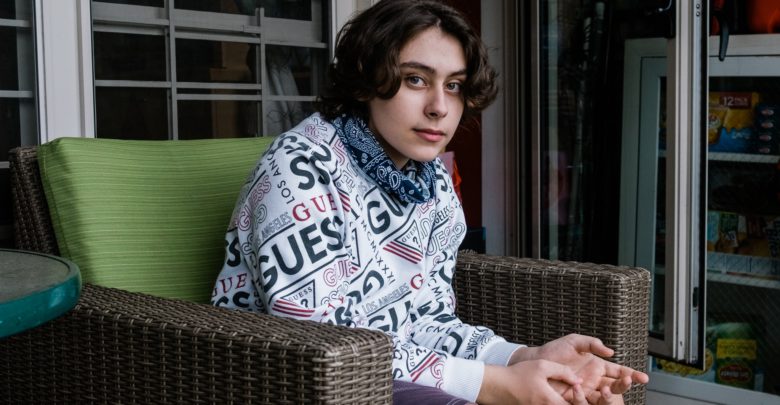
When a sprinkling of a reddish rash appeared on Jack McMorrow’s hands in mid-April, his father figured the 14-year-old was overusing hand sanitizer — not a bad thing during a global pandemic.
When Jack’s parents noticed that his eyes looked glossy, they attributed it to late nights of video games and TV.
When he developed a stomachache and didn’t want dinner, “they thought it was because I ate too many cookies or whatever,” said Jack, a ninth grader in Woodside, Queens, who loves Marvel Comics and has ambitions to teach himself “Stairway to Heaven” on the guitar.
But over the next 10 days, Jack felt increasingly unwell. His parents consulted his pediatricians in video appointments and took him to a weekend urgent care clinic. Then, one morning, he awoke unable to move.
He had a tennis-ball-size lymph node, raging fever, racing heartbeat and dangerously low blood pressure. Pain deluged his body in “a throbbing, stinging rush,” he said.
“You could feel it going through your veins and it was almost like someone injected you with straight-up fire,” he said.
Jack, who was previously healthy, was hospitalized with heart failure that day, in a stark example of the newly discovered severe inflammatory syndrome linked to the coronavirus that has already been identified in about 200 children in the United States and Europe and killed several.
The condition, which the Centers for Disease Control and Prevention are calling Multisystem Inflammatory Syndrome in Children, has shaken widespread confidence that children were largely spared from the pandemic. Instead of targeting lungs as the primary coronavirus infection does, it causes inflammation throughout the body and can cripple the heart. It has been compared to a rare childhood inflammatory illness called Kawasaki disease, but doctors have learned that the new syndrome affects the heart differently and erupts mostly in school-age children, rather than infants and toddlers. The syndrome often appears weeks after infection in children who did not experience first-phase coronavirus symptoms.
At a Senate hearing last week, Dr. Anthony S. Fauci, a leader of the government’s coronavirus response, warned that because of the syndrome, “we’ve got to be careful that we are not cavalier and thinking that children are completely immune to the deleterious effects.”

Jack’s recovery and the experience of other survivors are Rosetta stones for doctors, health officials and parents anxious to understand the mysterious condition.
“He could have definitely died,” said Dr. Gheorghe Ganea, who, along with his wife, Dr. Camelia Ganea, has been Jack’s primary doctor for years. “When there’s cardiovascular failure, other things can follow. Other organs can fail one after another, and survival becomes very difficult.”
New York State has reported three deaths and, as of Sunday, 137 cases were being investigated in the city alone. Last week, a C.D.C. alert urged doctors nationwide to report suspected cases.
“Everyone is doing everything they can to help look into this from all different angles just to get the answers that parents want, that we want,” said Dr. Thomas Connors, a pediatric critical care physician who treated Jack at NewYork-Presbyterian Morgan Stanley Children’s Hospital.
Neither Jack nor his parents, John McMorrow and Doris Stroman, know how he became infected with the coronavirus. After cleaning out his locker at Monsignor McClancy High School on March 18 to continue school online at home, he only left the apartment once, they said, to help his mother wash clothes in their high-rise building’s laundry room. His parents and 22-year-old sister also avoided going out and the tests they have had turned up negative.

Last week, in their apartment festooned with welcome-home balloons, the family — Jack wearing a blue bandanna as a mask, his mother in a mask with the Rolling Stones tongue logo on it — recounted their story. His father, a recently laid-off truck driver for the film industry, briefly choked up and Jack bounded over to hug him.
The week after his hand rash and stomachache, about a month after he had last set foot in school, Jack developed a 102-degree fever and a sore throat. Worried, his mother arranged a video visit with their pediatricians, who started him on an antibiotic for possible bacterial infection. For several days, he felt about the same, but then other symptoms rapidly emerged: swollen neck, nausea, dry cough, a metallic taste.
On Saturday, April 25, his fever spiked to 104.7, his chest felt tight, and when he took deep breaths, “it hurt down in the bottom,” he said.


That morning, Dr. Camelia Ganea video-conferenced with the family while still in her pajamas, discovering Jack could barely open his mouth. She prescribed steroids and suggested they visit an urgent care clinic. There, Jack was tested for the coronavirus, but it would be two days before results arrived.
By Monday, pain was “flowing through me like lightning,” Jack said, and a rosy rash covered his feet.
“I was very very emotional,” Jack said. He paused. “I’m using the word emotional to cover up the fact I was crying like a baby.”
Lying on the sofa, he could not move on his own and grasped for words to describe what was happening.
“Rooftop,” he implored his parents, seeking a shorthand way to ask them to bend his leg like a peaked roof.
“I didn’t know what I was trying to say, but I knew what I meant,” he explained later.
With a home monitor, they discovered his blood pressure was very low. Mr. McMorrow lifted him, placing Jack’s feet on top of his own, and shuffled him to the car. At NewYork-Presbyterian/Weill Cornell hospital, doctors gave Jack intravenous fluids and tried to diagnose his condition. He did not have the obvious respiratory distress of Covid-19. And then they got the results of his Saturday coronavirus test: negative.
Suspecting he might have a condition like mononucleosis, they prepared to discharge him, thinking he could be safely watched at home with instructions to return if his blood pressure dropped again, his parents said.
His mother was urging them to keep Jack longer when his eyes turned red with a “raging case of pinkeye” and rolled back in his head, she said. After a conversation with Jack’s pediatrician, the hospital conducted its own coronavirus test. It was positive.
The doctor decided Jack should be transferred to NewYork-Presbyterian’s pediatric affiliate, Morgan Stanley Children’s Hospital, which is treating many coronavirus cases. Jack begged to go home.
The doctor responded bluntly, saying she knew that teenagers often think they are invincible.
“She told me if I go home now, by tomorrow, I’ll be dead,” Jack said. “I would say that scared me to death, but it more scared me to life. It scared me to fight as hard as I could.”

Jack arrived at the children’s hospital so feverish that his father was “washing me down with ice-cold water and it only felt like a tingle,” he said.
His resting heart rate was 165 beats per minute, about twice as high as normal, as his heart struggled to compensate for his alarmingly low blood pressure, which was hampering its ability to circulate blood and supply his vital organs with oxygen and nutrients.
This condition is a form of heart failure called cardiogenic shock, and Jack’s was “pretty severe,” said Dr. Steven Kernie, chief of pediatric critical care medicine at the hospital and Columbia University. “Over all, his heart wasn’t working very well,” he said. “It wasn’t pumping as strongly as normal.”
Doctors could not explain why Jack’s heart function had suddenly become impaired. Its structure and rhythm were normal. But blood vessels throughout his body were inflamed, a condition called vasculitis, so the vessels’ muscles were “not controlling blood flow as well as they should,” Dr. Kernie said.
Doctors also suspected that the heart was inflamed, known as myocarditis, which in untreated serious cases can cause lasting damage.
Jack’s condition was not only distressing, it reflected a frightening new pattern. “I remember that morning having admitted multiple children with a similar syndrome,” Dr. Connors said, “and it was kind of like, ‘What’s going on here?’”
The inflammation seemed driven by a hyperactive immune response, and Jack received medication for bacterial infection until tests ruled that out. “Whenever kids come in in shock you have to treat for everything,” Dr. Kernie said.
Jack’s positive coronavirus test was a clue, but others with similar symptoms had negative diagnostic test results, Dr. Connors said. The doctors then decided to check the other children for evidence of the coronavirus with a different test, one for antibodies, which signal they had an earlier, no-longer-active infection. Most children ended up having either a positive diagnostic or antibody test result.
By April 29, Jack’s third day in the I.C.U., the blood pressure medication was not helping enough and doctors began planning to insert a central line through his groin to deliver additional medications. They also prepared to put Jack, who was receiving nasal oxygen, on a ventilator, something doctors deem necessary when “your heart’s not doing its job,” Dr. Connors said. “We didn’t know which way this was going.”
The situation, especially the prospect of a ventilator, was terrifying to Mr. McMorrow, 51, who stayed in Jack’s hospital room round-the-clock, and Ms. Stroman, 52, who was at home communicating by text and FaceTime because only one parent was allowed in the hospital.
“You had a cardiologist, a pulmonary specialist, infectious disease experts all throwing numbers and prescriptions to each other, and this is stuff that’s French to me,” Mr. McMorrow said.
Jack mustered the energy to ask the doctors questions. “I needed to know because how am I supposed to fight something I don’t know I’m fighting,” he said.
He concluded that his condition essentially boiled down to: “Your coronary and pulmonary responses come back and bite you in the butt.”
But then doctors began giving Jack steroids, which can have anti-inflammatory and immunosuppressant effects. At last, something seemed to work. Within hours, Jack needed less blood pressure medication. As the family’s pediatrician, Dr. Ganea, who has training in infectious diseases and spoke to the hospital team, put it: “Jack turned into a normal Jack.”
Doctors are not sure the steroids made the difference, but since then, they have administered them much earlier to children with the syndrome, with encouraging results, Dr. Kernie said.
But Jack was not out of the woods even after moving to a regular hospital room. His heart rate was in the 30s, about half what it should be. The low heart rate might have been because of the steroids, doctors said, but they could not be sure, so they moved Jack to a unit with continual cardiac monitoring.
Over the next week, Jack recovered. He emailed his biology teacher from his hospital bed: “I would like to thank you for educating me as you did, and for providing me the educational support to understand my body when I need to most.”
His mother knew Jack was his old self when, on the phone, he asked to speak with his sister, quoting the family’s favorite movie, “Midnight Run”: “Is this moron No. 1? Put moron No. 2 on the phone.”


On May 7, 10 days after being hospitalized, Jack went home and traipsed around the apartment channeling Pinocchio: “I’m a boy! There are no strings on me!”
He will require follow-up cardiology appointments and will take steroids and blood thinners for a while. He may have some heart-valve tears and residual cardiac inflammation, but doctors expect those to heal on their own. Jack and his family have taken genetic tests as part of research into the syndrome, and he and other survivors will be followed as doctors strive to learn how to recognize and treat it.
Pausing near a model of Darth Vader’s castle on his desk, Jack said he once considered becoming an actor. He was even an extra on the TV show “Gotham,” playing a kidnapped orphan. But before getting sick, he was thinking about studying medicine. “I was really into the heart,” he said. Now, he is even more interested.
“I just want to do more with my life now that I have it back,” he said, gesturing with his Captain America shield.
Artikel ini telah tayang di nytimes.com dengan judul “‘Straight-Up Fire’ in His Veins: Teen Battles New Covid Syndrome”, https://www.nytimes.com/2020/05/17/health/coronavirus-multisystem-fnflammatory-syndrome-children-teenagers.html
Penulis/Editor : Pam Belluck is a health and science writer. She was one of seven Times staffers awarded the 2015 Pulitzer Prize for International Reporting for coverage of the Ebola epidemic. She is the author of “Island Practice,” about a colorful and contrarian doctor on Nantucket.
Foto Cover : Credit…Gabriela Bhaskar for The New York Times



